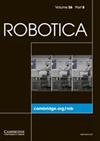基于抓取力补偿和线性化的软体机器人手指可变刚度设计方法
IF 2.7
4区 计算机科学
Q3 ROBOTICS
引用次数: 0
摘要
软手指在机器人抓手中发挥着越来越重要的作用,可实现具有可变刚度特征的自适应抓取。以往关于软手指设计的研究主要集中在优化现有手指结构的结构参数上,但在从基本抓取机制到具有所需抓取力特征的手指结构的设计方法上所做的努力却很有限。为此,我们提出了软手指的基本结构,用于分析软手指的常见特征以及内部结构对整体抓取性能的影响。此外,还引入了三个一般性能指标来评估软手指设计的抓取性能。然后,提出了一种新方法,将可变刚度结构与基本结构相结合,以补偿手指的抓取力和线性化。随后,根据该方法提出了基于悬臂弹簧的可变刚度(CSVS)机构的具体设计方案,并采用多目标优化方法对设计方案进行了优化。此外,还通过有限元分析(FEA)分析了 CSVS 的特征,并通过比较 V 形手指和 CSVS 手指的抓取性能,证明该设计方法能有效缩短前抓取阶段,并使后抓取阶段的抓取力线性化,同时降低手指与被抓取物体之间滑动摩擦的可能性。最后,通过实验验证了有限元分析模型的准确性、设计方法的有效性以及 CSVS 手指的适应性。本文章由计算机程序翻译,如有差异,请以英文原文为准。
A variable stiffness design method for soft robotic fingers based on grasping force compensation and linearization
Soft fingers play an increasingly important role in robotic grippers to achieve adaptive grasping with variable stiffness features. Previous studies of soft finger design have primarily focused on the optimization of the structural parameters of existing finger structures, but limited efforts have been put into the design methodology from fundamental grasping mechanisms to finger structures with desired grasping force features. To this aim, a fundamental architecture of soft fingers is proposed for analyzing common soft finger features and the influence of the internal structures on the overall grasping performance. In addition, three general performance metrics are introduced to evaluate the grasping performance of soft finger designs. Then, a novel method is proposed to combine the variable stiffness structure with the fundamental architecture to compensate for the grasping force of the finger and linearization. Subsequently, an embodiment design is proposed with a cantilever spring-based variable stiffness (CSVS) mechanism based on the method, and a multi-objective optimization method is employed to optimize the design. Besides, the CSVS features are analyzed through finite element analysis (FEA), and by comparing the grasping performance between the V-shape finger and the CSVS finger, it is demonstrated that the design method can effectively shorten the pre-grasp stage and linearize the grasping force in the post-grasp stage while reducing the likelihood of sliding friction between the finger and the grasped object. Finally, experiments are conducted to validate the accuracy of the FEA model, the effectiveness of the design methodology, and the adaptability of the CSVS finger.
求助全文
通过发布文献求助,成功后即可免费获取论文全文。
去求助
来源期刊

Robotica
工程技术-机器人学
CiteScore
4.50
自引率
22.20%
发文量
181
审稿时长
9.9 months
期刊介绍:
Robotica is a forum for the multidisciplinary subject of robotics and encourages developments, applications and research in this important field of automation and robotics with regard to industry, health, education and economic and social aspects of relevance. Coverage includes activities in hostile environments, applications in the service and manufacturing industries, biological robotics, dynamics and kinematics involved in robot design and uses, on-line robots, robot task planning, rehabilitation robotics, sensory perception, software in the widest sense, particularly in respect of programming languages and links with CAD/CAM systems, telerobotics and various other areas. In addition, interest is focused on various Artificial Intelligence topics of theoretical and practical interest.
 求助内容:
求助内容: 应助结果提醒方式:
应助结果提醒方式:


